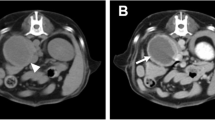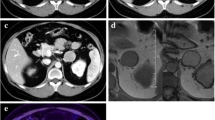Abstract
We present an interesting case with a central mediastinal pheochromocytoma showing intense F-18 fluorodeoxyglucose (FDG) uptake in tumor and systemic brown adipose tissue (BAT) mimicking metastases. The findings of hypertension and high plasma catecholamine concentration suggested the presence of pheochromocytoma. Mediastinal tumor showed intense FDG uptake and faint uptake of I-131 metaiodobenzylguanidine. Intense FDG uptake was demonstrated in cervical, paravertebral, mediastinal, and perirenal regions. Positron emission tomography and computed tomography (PET/CT) revealed uptake in a fat density area suggesting that the FDG uptake had occurred in BAT. The mediastinal tumor was resected along with an adhesion to the left atrial wall and pathologically confirmed as pheochromocytoma. The plasma catecholamine concentration and blood pressure then reverted to normal. The FDG uptake in BAT disappeared after tumor resection.
Similar content being viewed by others
References
Shulkin BL, Koeppe RA, Francis IR, Deeb GM, Lloyd RV, Thompson NW. Pheochromocytomas that do not accumulate metaiodobenzylguanidine: localization with PET and administration of FDG. Radiology 1993;186:711–715.
Maurea S, Mainolfi C, Wang H, Varrella P, Panico MR, Klain M, et al. Positron emission tomography (PET) with F-18-fluorodeoxyglucose in the study of adrenal masses: comparison of benign and malignant lesions. Radiol Med (Torino) 1996;92:782–787.
Hany TF, Gharehpapagh E, Kamel EM, Buck A, Himms-Hagen J, von Schulthess GK. Brown adipose tissue: a factor to consider in symmetrical tracer uptake in the neck and upper chest region. Eur J Nucl Med Mol Imaging 2002;29:1393–1398.
Cohade C, Osman M, Pannu HK, Wahl RL. Uptake in supraclavicular area fat (“USA-Fat”): description on 18F-FDG PET/CT. J Nucl Med 2003;44:170–176.
Fukuchi K, Tatsumi M, Ishida Y, Oku N, Hatazawa J, Wahl RL. Radionuclide imaging metabolic activity of brown adipose tissue in a patient with pheochromocytoma. Exp Clin Endocrinol Diabetes 2004;112:601–603.
English JT, Patel SK, Flanagan MJ. Association of pheochromocytomas with brown fat tumors. Radiology 1973;107:279–281.
Lean ME, James WP, Jennings G, Trayhurn P. Brown adipose tissue in patients with phaeochromocytoma. Int J Obes 1986;10:219–227.
Elsayes KM, Narra VR, Leyendecker JR, Francis IR, Lewis JS Jr, Brown JJ. MRI of adrenal and extraadrenal pheochromocytoma. AJR Am J Roentgenol 2005;184:860–867.
Kopf D, Bockisch A, Steinert H, Hahn K, Beyer J, Neumann HP, et al. Octreotide scintigraphy and catecholamine response to an octreotide challenge in malignant phaeochromocytoma. Clin Endocrinol (Oxf) 1997;46:39–44.
Chernogubova E, Cannon B, Bengtsson T. Norepinephrine increases glucose transport in brown adipocytes via beta 3-adrenoceptors through a cAMP, PKA, and PI3-kinase-dependent pathway stimulating conventional and novel PKCs. Endocrinology 2004;145:269–280.
Tatsumi M, Engles JM, Ishimori T, Nicely O, Cohade C, Wahl RL. Intense 18F-FDG uptake in brown fat can be reduced pharmacologically. J Nucl Med 2004;45:1189–1193.
Soderlund V, Larsson SA, Jacobsson H. Reduction of FDG uptake in brown adipose tissue in clinical patients by a single dose of propranolol. Eur J Nucl Med Mol Imaging 2007;34:1018–1022.
Menzel C, Graichen S, Berner U, Risse JH, Diehl M, Dobert N, et al. Monitoring the efficacy of iodine-131-MIBG therapy using fluorine-18-FDG-PET. Acta Med Austriaca 2003;30:37–40.
Ezuddin S, Fragkaki C. MIBG and FDG PET findings in a patient with malignant pheochromocytoma: a significant discrepancy. Clin Nucl Med 2005;30:579–581.
Glodny B, Winde G, Herwig R, Meier A, Kuhle C, Cromme S, et al. Clinical differences between benign and malignant pheochromocytomas. Endocr J 2001;48:151–159.
Kumaki N, Kajiwara H, Kameyama K, DeLellis RA, Asa SL, Osamura RY, et al. Prediction of malignant behavior of pheochromocytomas and paragangliomas using immunohistochemical techniques. Endocr Pathol 2002;13:149–156.
Elsayes KM, Mukundan G, Narra VR, Lewis JS Jr, Shirkhoda A, Farooki A, et al. Adrenal masses: MR imaging features with pathologic correlation. Radiographics 2004;24Suppl 1:S73–S86.
Author information
Authors and Affiliations
Corresponding author
Rights and permissions
About this article
Cite this article
Kuji, I., Imabayashi, E., Minagawa, A. et al. Brown adipose tissue demonstrating intense FDG uptake in a patient with mediastinal pheochromocytoma. Ann Nucl Med 22, 231–235 (2008). https://doi.org/10.1007/s12149-007-0096-x
Received:
Accepted:
Published:
Issue Date:
DOI: https://doi.org/10.1007/s12149-007-0096-x




